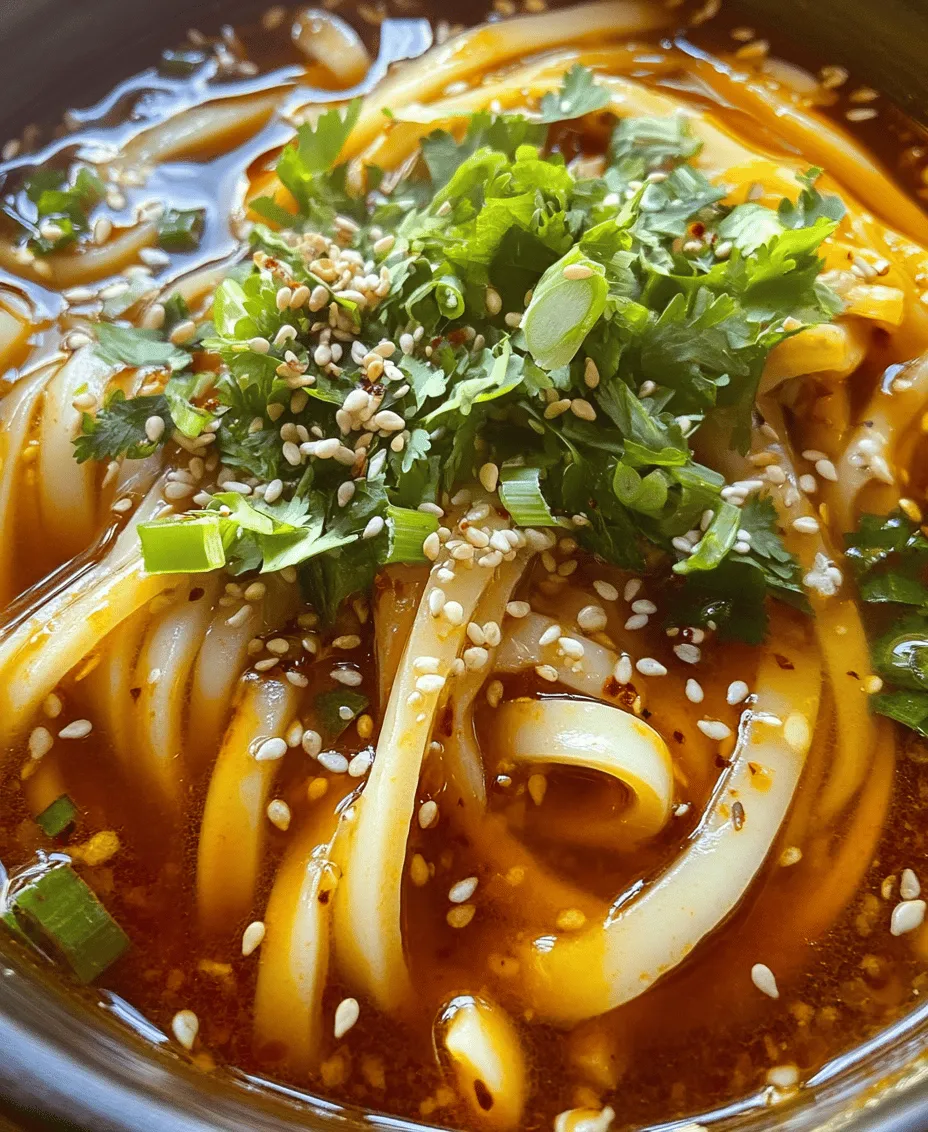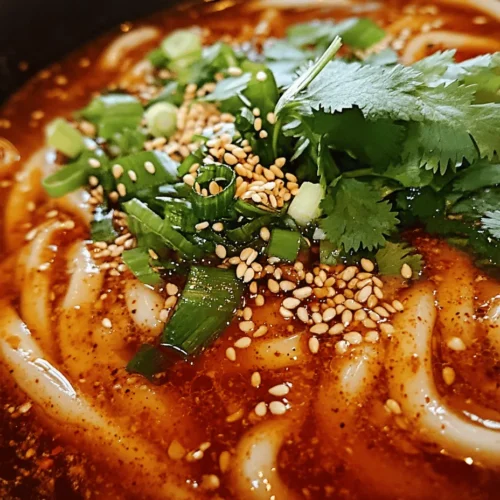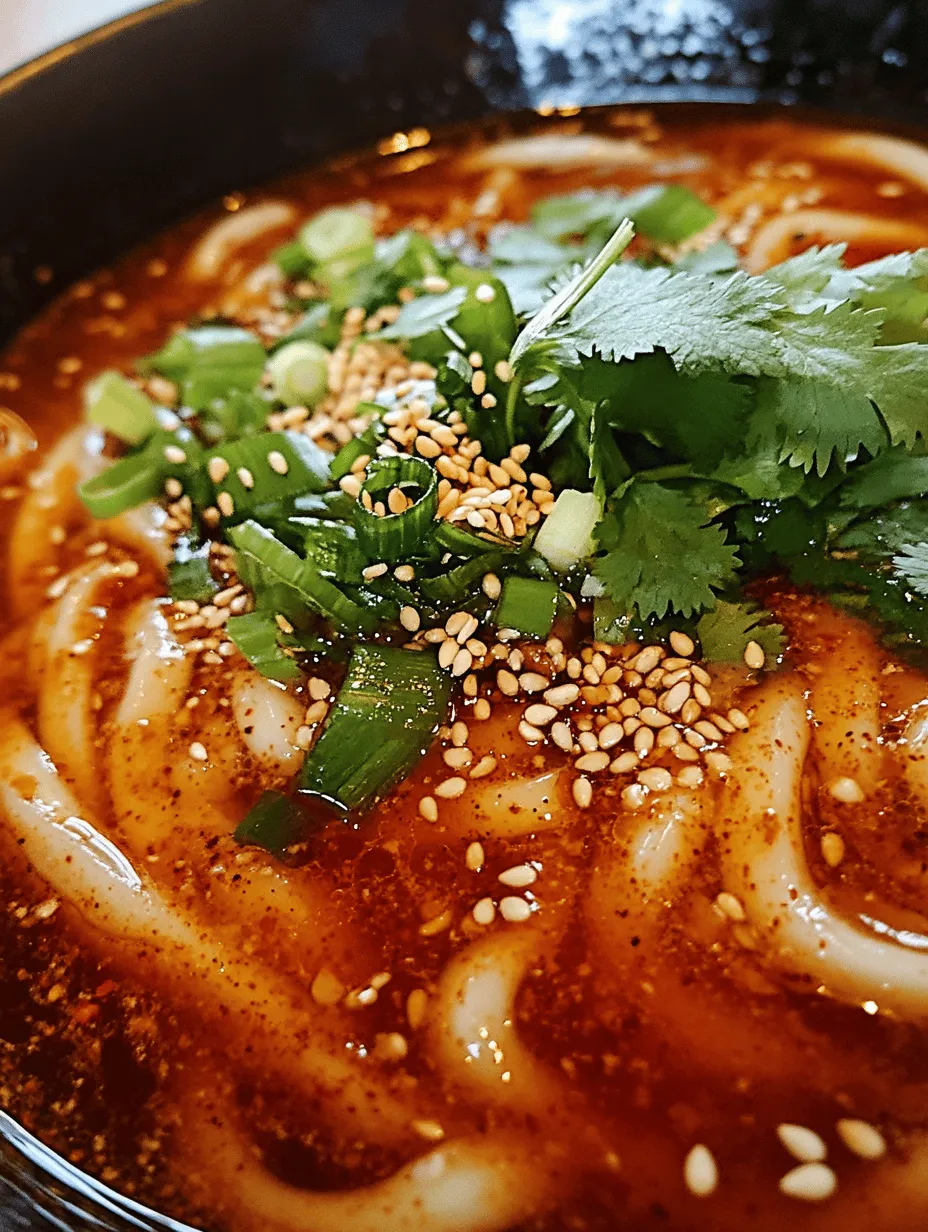Introduction
Udon noodles are a staple in Asian cuisine, revered for their thick, chewy texture and ability to absorb flavors. Originating from Japan, these versatile noodles have gained international popularity, becoming a beloved choice for home cooks and chefs alike. Whether served in a steaming bowl of broth, stir-fried with an array of vegetables, or dressed in a zesty sauce, udon noodles provide a satisfying and hearty meal option that caters to various tastes and dietary preferences.
One of the key elements that elevate udon noodles to new heights is chili oil. This flavorful condiment is made by infusing oil with chili peppers and other spices, resulting in a rich, aromatic oil that adds depth and heat to any dish. The inclusion of chili oil can transform a simple plate of noodles into an exciting culinary experience, making it an essential ingredient in many Asian recipes. As the world becomes increasingly fast-paced, the demand for quick yet delicious meals has surged. The Spicy 10-Minute Chili Oil Udon Noodles recipe perfectly aligns with this trend, offering a flavorful dish that can be prepared in just ten minutes, making it an ideal choice for busy weeknights or a quick lunch.
In this article, we will explore the delightful combination of udon noodles and chili oil, providing you with a step-by-step guide to create this delicious meal. With its spicy kick and rich flavors, this recipe promises to awaken your taste buds and satisfy your cravings, all without spending hours in the kitchen.
Understanding Udon Noodles
Udon noodles are thick, wheat-based noodles that are a staple in Japanese cuisine. Their origins can be traced back to ancient China and Japan, where they have been enjoyed for centuries. The chewy texture of udon noodles sets them apart from their thinner counterparts, making them a popular choice for soups, stir-fries, and cold noodle dishes. They can vary in thickness, but typically, they are about 4-6 mm wide, giving them a hearty bite that pairs wonderfully with various sauces and toppings.
Nutritionally, udon noodles offer several benefits. They are primarily made from wheat flour, which provides a good source of carbohydrates, essential for energy. Depending on the brand and preparation method, udon noodles can also contain protein and small amounts of fiber. Whole grain udon options are available for those looking to increase their fiber intake, making them a healthier choice. Additionally, udon noodles are often low in fat, allowing them to fit into various dietary plans.
Beyond this recipe, udon noodles can be used in numerous culinary applications. They can be served in a traditional noodle soup, stir-fried with vegetables and proteins, or enjoyed cold with a dipping sauce. Their adaptability makes them an excellent ingredient for experimentation in the kitchen.
The Magic of Chili Oil
Chili oil is more than just a condiment; it is a flavor enhancer that has become a beloved staple in many kitchens around the world. This oil is created by infusing cooking oil with dried chili peppers, garlic, and sometimes additional spices like ginger or Sichuan peppercorns. The result is a vibrant, flavorful oil that adds a tantalizing heat to dishes.
There are various types of chili oils available in the market, each with its unique flavor profile. Some are made with a blend of herbs and spices for added complexity, while others focus on the pure heat of the chili. When choosing a chili oil, consider the level of spiciness and additional flavor components that may complement your dish. For those who enjoy a more personalized touch, homemade chili oil is a rewarding option. It allows you to customize the flavors and heat level to suit your preferences.
Chili oil is not just about heat; it also offers several health benefits. It may help boost metabolism, thanks to the capsaicin found in chili peppers, which can aid in burning calories. Additionally, chili oil has anti-inflammatory properties that may contribute to overall health when consumed in moderation. Incorporating chili oil into your cooking is an excellent way to add flavor while potentially reaping some health benefits.
As you embark on your culinary adventure with this Spicy 10-Minute Chili Oil Udon Noodles recipe, think of chili oil as your secret weapon. A drizzle can enhance not only udon noodles but also a variety of dishes, from fried rice and grilled meats to roasted vegetables and salad dressings. Its versatility makes it a must-have in any kitchen.
Ingredient Breakdown
To create your Spicy 10-Minute Chili Oil Udon Noodles, you’ll need a few key ingredients, each contributing to the dish’s overall flavor and texture.
Udon Noodles
Description: Udon noodles are the star of this recipe. They are thick, chewy, and absorb flavors beautifully, making them the perfect base for a spicy dish.
Cooking Tips: When cooking udon noodles, it’s essential to follow the package instructions. Fresh udon noodles typically require only a few minutes of boiling, while dried udon may take longer. Once cooked, rinse them under cold water to stop the cooking process and prevent them from becoming gummy.
Variations: While the traditional udon noodles are wheat-based, you can also find gluten-free options made from rice or other grains, catering to those with dietary restrictions.
Chili Oil
Description: This flavorful oil is what gives the dish its signature heat. You can use store-bought chili oil or make your own by infusing oil with dried chili flakes.
Types: Look for chili oils that suit your taste preferences. Some may have additional flavorings, such as garlic or sesame, while others focus purely on the chili flavor.
Homemade Options: To make your own chili oil, simply heat oil (like vegetable or canola) and add dried chili flakes, allowing them to infuse for a few minutes before removing from heat. This method lets you control the spice level and flavor.
Garlic
Description: Garlic adds depth and richness to the dish. Its aromatic qualities complement the spiciness of the chili oil beautifully.
Health Benefits: Garlic is well-known for its numerous health benefits, including its potential to boost the immune system and reduce blood pressure. It also adds a savory flavor that enhances any dish.
Culinary Uses: In this recipe, garlic is typically minced and sautéed to release its flavor before being combined with the other ingredients. You can also use garlic powder as a quick alternative.
Soy Sauce
Description: Soy sauce is a fundamental ingredient in many Asian cuisines, adding umami and saltiness to the dish.
Varieties: There are different types of soy sauce, including light and dark soy sauce. Light soy sauce is saltier and typically used in marinades, while dark soy sauce adds color and a slightly sweeter flavor.
Flavor Profiles: Choose a soy sauce that matches your desired flavor intensity. Tamari is a gluten-free alternative that can also be used.
Rice Vinegar
Description: Rice vinegar offers a tangy balance to the heat from the chili oil, enhancing the overall flavor profile of the dish.
Role in Balancing Flavors: The acidity of rice vinegar helps to cut through the richness of the oil and adds brightness to the noodles. It’s a crucial ingredient for achieving a well-rounded flavor.
In the next section, we will dive into the step-by-step instructions for preparing the Spicy 10-Minute Chili Oil Udon Noodles, ensuring you have all the guidance you need to create this delightful dish in your own kitchen. Stay tuned for a flavorful culinary experience that is quick, easy, and utterly satisfying.

Sesame Oil: Flavor Enhancer and Nutritional Benefits
Sesame oil plays a pivotal role in elevating the flavor profile of Spicy 10-Minute Chili Oil Udon Noodles. Not only does it impart a rich, nutty aroma, but it also brings a wealth of nutritional benefits. Rich in antioxidants, sesame oil can help combat oxidative stress in the body. It is also a source of healthy fats, specifically polyunsaturated and monounsaturated fats, which are beneficial for heart health. Additionally, sesame oil contains lignans, which have been linked to improved cholesterol levels and overall cardiovascular health.
By incorporating sesame oil into your udon noodles, you not only enhance the dish’s complexity but also contribute to a healthier meal. This oil helps to balance the heat from the chili, creating a harmonious flavor experience that is both comforting and satisfying.
Green Onions and Red Chili: Garnishing and Additional Heat
Green onions, also known as scallions, are a classic garnish that adds a fresh, crisp texture to your udon noodles. They provide a mild onion flavor that complements the heat of the chili oil, creating a delightful contrast. When sliced thinly, green onions not only enhance the visual appeal of the dish but also add a burst of freshness that cuts through the richness of the oil.
For those who crave an additional kick, incorporating red chili slices is essential. These not only amplify the spiciness of the dish but also add vibrant color, making your meal visually enticing. Choose fresh red chilies or dried chili flakes based on your heat preference, and feel free to adjust the quantity to suit your taste.
Sesame Seeds and Fresh Herbs: Visual Appeal and Flavor Accents
To finish off your Spicy 10-Minute Chili Oil Udon Noodles, a sprinkle of sesame seeds can make a world of difference. These tiny seeds add a delightful crunch and a slightly sweet, nutty flavor that enhances the overall eating experience. Toasting the sesame seeds briefly before use can intensify their flavor, making them an excellent addition to any noodle dish.
Fresh herbs, such as cilantro or basil, can also be used to garnish your udon noodles. Their aromatic qualities not only elevate the dish’s presentation but also add a layer of freshness that balances the heat from the chili oil. A handful of chopped herbs can transform your noodles into a gourmet dish that looks as good as it tastes.
Step-by-Step Cooking Instructions
Cooking the Udon Noodles: Tips for Perfect Texture
1. Boil Water: Start by bringing a large pot of water to a rolling boil. Make sure you have enough water to allow the udon noodles to move freely.
2. Add Udon Noodles: Once the water is boiling, add the udon noodles. Stir gently to prevent them from sticking together.
3. Cooking Time: Cook the noodles for about 3-5 minutes, or according to the package instructions. Fresh udon noodles typically require less time than dried ones.
4. Test for Doneness: Taste a strand of noodle to ensure they are cooked to your desired texture. They should be tender yet still have a slight bite (al dente).
5. Drain and Rinse: Once cooked, drain the noodles in a colander and rinse them briefly under cold water to stop the cooking process. This will also help to remove excess starch, preventing them from clumping.
Preparing the Chili Oil: Achieving the Right Flavor Balance
1. Gather Ingredients: For the chili oil, you’ll need sesame oil, red pepper flakes, and any additional spices you wish to include, such as garlic powder or ginger.
2. Heat the Oil: In a small saucepan, heat 1/4 cup of sesame oil over medium heat. Be careful not to let it smoke.
3. Add Spices: Once the oil is warm, add 2 tablespoons of red pepper flakes and stir continuously for about 30 seconds. This helps to infuse the oil with heat and flavor.
4. Flavor Testing: If desired, add a pinch of garlic powder or ginger to enhance the flavor further. Adjust the amount of red pepper flakes based on your preferred spice level.
5. Cool and Store: Remove the oil from heat and let it cool slightly before using. You can store any leftover chili oil in a sealed container for future use.
Combining and Tossing the Ingredients: Ensuring Every Noodle is Coated
1. Combine Noodles and Oil: In a large mixing bowl, add the drained udon noodles. Pour the prepared chili oil over the noodles while the oil is still warm.
2. Toss Gently: Using tongs or chopsticks, gently toss the noodles to ensure they are evenly coated with the chili oil. This is crucial for flavor distribution.
3. Add Garnishes: Sprinkle in the sliced green onions, red chili slices, sesame seeds, and any chopped fresh herbs. Toss again to mix everything together.
4. Final Adjustments: Taste the noodles and adjust the seasoning, adding more chili oil or sesame oil if desired.
5. Timing is Key: Aim to serve the noodles immediately after tossing. This ensures the flavors are fresh and vibrant, and the noodles maintain their ideal texture.
Serving Suggestions
Recommended Pairings to Enhance the Meal Experience
To elevate your Spicy 10-Minute Chili Oil Udon Noodles, consider pairing them with complementary dishes that enhance the overall meal experience. A refreshing cucumber salad dressed with rice vinegar and sesame oil can provide a cool contrast to the heat of the noodles. Alternatively, a simple miso soup can serve as a comforting side that complements the rich flavors of the udon.
Side Dishes that Complement Udon Noodles
1. Vegetable Tempura: The light and crispy texture of tempura vegetables contrasts nicely with the chewy udon, making for a delightful combination.
2. Pickled Vegetables: Serve a small dish of pickled daikon or kimchi on the side to add a tangy flavor that cuts through the spiciness of the noodles.
3. Steamed Edamame: Lightly salted edamame makes for a healthy, protein-packed side that pairs well with the udon noodles.
Beverage Pairings that Balance the Spiciness of the Dish
When it comes to beverages, a light, refreshing drink can help balance the heat of your udon noodles. Consider pairing your meal with:
1. Iced Green Tea: The subtle flavors of green tea provide a refreshing contrast to the spiciness of the noodles.
2. Lemonade or Limeade: The tartness of citrus drinks can help cool the palate, making them a perfect match for spicy foods.
3. Light Beer or Sake: For those who prefer an alcoholic beverage, a light lager or a chilled sake can complement the flavors beautifully without overpowering them.
Creative Ways to Customize the Dish with Additional Toppings or Proteins
Feel free to customize your Spicy 10-Minute Chili Oil Udon Noodles by adding different proteins or toppings. Some suggestions include:
1. Grilled Chicken or Tofu: Add slices of grilled chicken or marinated tofu for a protein boost.
2. Soft-Boiled Egg: A soft-boiled egg, with its runny yolk, can add creaminess that balances the chili heat.
3. Vegetables: Incorporate sautéed or stir-fried vegetables such as bell peppers, bok choy, or mushrooms to make the dish even more nutritious and colorful.
Nutritional Information
When enjoying your Spicy 10-Minute Chili Oil Udon Noodles, it’s helpful to consider the nutritional content. Below is a breakdown of the approximate values per serving:
– Calories: 450
– Protein: 12g
– Carbohydrates: 68g
– Fat: 18g
– Fiber: 3g
Breakdown of Nutritional Values per Serving
The primary ingredients in this recipe provide a balanced meal, combining carbohydrates from the udon noodles, healthy fats from the sesame oil, and protein from any added toppings. The vegetables and herbs contribute vitamins and minerals, making this dish not only delicious but also nutritious.
Discussion on Dietary Considerations (Vegan, Gluten-Free Options)
This recipe is naturally vegan, making it suitable for those following a plant-based diet. However, if you require a gluten-free option, consider using gluten-free udon noodles made from rice or buckwheat. Additionally, ensure that your soy sauce or any other sauce used is gluten-free to maintain the integrity of the dish.
Conclusion
Spicy 10-Minute Chili Oil Udon Noodles are a quick, flavorful, and satisfying meal that can be easily prepared at home. This recipe offers a perfect blend of heat, texture, and nutritional benefits, making it an ideal choice for busy weeknights or casual gatherings. The versatility of the dish allows for endless customization, encouraging you to experiment with different toppings and sides that cater to your preferences.
Remember, the joy of cooking lies in making the dish your own. Whether you stick to the classic version or add your personal touches, these udon noodles are sure to become a favorite in your culinary repertoire. Enjoy the process, savor the flavors, and most importantly, have fun in the kitchen!



